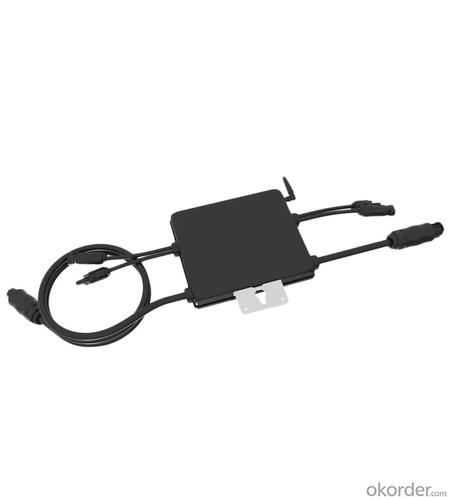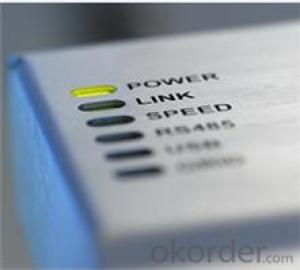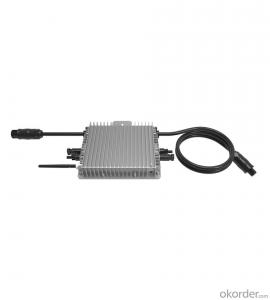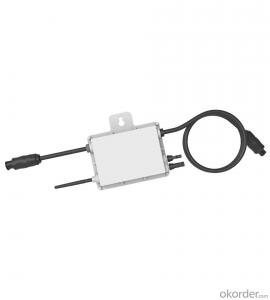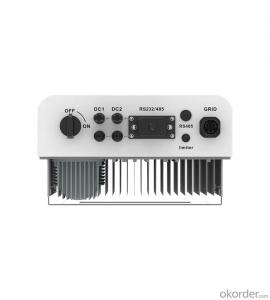Gan Solar Inverter Sun500g/600g | 500-600w | Single Phase | 2 MPPT | Micro-Inverter | Rapid Shutdown
- Loading Port:
- Ningbo
- Payment Terms:
- TT OR LC
- Min Order Qty:
- 100 pc
- Supply Capability:
- 5000 pc/month
OKorder Service Pledge
OKorder Financial Service
You Might Also Like
Specification
The series microinverter features low startup voltage of 20V and Max. DC input volage of 60V. Module-level monitoring providing each panel’s performance data, faster O&M. With built-in WIFI module, easier installation and commissioning for installer. Also, it supports various output voltage and frequency, 127/208/240V@60Hz, 230V/50Hz.
Rapid shutdown function
IP67 protection degree,10 years warranty
PLC, Zigbee or WIFI communication
2 MPP trackers, module level monitoring
Cooling glue filling, good thermal performance
Suitable for Europe, North America, South America and other regions
| Model | SUN500G-230-EU | SUN600G2-US-208/240 | SUN600G2-US-220 | SUN600G2-US-127 |
| Input Data (DC) | ||||
| Recommended input Power (STC) | 210~400W (2 Pieces) | 210~400W (2 Pieces) | 210~400W (2 Pieces) | 210~350W |
| Maximum input DC Voltage | 60V | |||
| MPPT Voltage Range | 25~55V | |||
| Operating DC Voltage Range | 20~60V | |||
| Max. DC Short Circuit Current | 13A | |||
| Max. input Current | 10.4A×2 | |||
| Output Data (AC) | ||||
| Rated output Power | 600W | 600W | 600W | 500W |
| Maximum output Power | 600W | 600W | 600W | 500W |
| Maximum output Current | 2.2A | 2.9A / 2.5A | 2.7A | 4A |
| Nominal Voltage / Range | 184~265V | 208V / 183~229V 240V / 211~264V | 220V/176~242V | a.c.95~155V @127Vac |
| Nominal Frequency / Range | 50.0 / 47.5~51.5Hz | 60.0 / 59.3~60.5Hz | 60.0 / 59.3~60.5Hz | 60.0 / 59.3~60.5Hz |
| Extended Frequency / Range | 50.0 / 45~55Hz | 60.0 / 55~65Hz | 60.0 / 55~65Hz | 60.0 / 55~65Hz |
| Power Factor | >0.99 | |||
| Maximum units per branch | 11 8 / 10 9 6 | |||
| Efficiency | ||||
| CEC Weighted Efficiency | 95% | |||
| Peak Inverter Efficiency | 96.5% | |||
| Static MPPT Efficiency | 99% | |||
| Night Time Power Consumption | 50mW | |||
| Mechanical Data | ||||
| Ambient Temperature Range | -40~65℃ | |||
| Size (mm) | 185W×161H×29D (Without mounting bracket and cable) | |||
| Weight (kg) | 2.4 | |||
| Cooling | Natural cooling | |||
| Enclosure Environmental Rating | IP67 | |||
| Features | ||||
| Compatibility | Compatible with 60~72 cell PV modules | |||
| Communication | Power line / WIFI / Zigbee | |||
| Compliance | UL1741、VDE0126、VDE4105、IEC62109、CE、INMETRO | |||
| Warranty | 10 years | |||
- Q: Can a solar inverter be used with solar trackers?
- Yes, a solar inverter can be used with solar trackers. Solar trackers are designed to move solar panels throughout the day to optimize their exposure to the sun. The inverter is responsible for converting the DC electricity generated by the solar panels into AC electricity that can be used to power various appliances and devices. Therefore, the inverter is an essential component in any solar power system, including those with solar trackers.
- Q: How does a solar inverter handle voltage and frequency variations caused by switching operations?
- Through its built-in control mechanisms and advanced technology, a solar inverter is specifically designed to handle voltage and frequency variations resulting from switching operations. When connected to the grid, the solar inverter actively monitors the grid's voltage and frequency, and adjusts its operation accordingly to ensure stability and safety. When voltage variations occur due to switching operations, a solar inverter typically employs a voltage control mechanism. This mechanism continuously monitors the grid's voltage level, and accordingly adjusts the inverter's output voltage to match the grid voltage. If the grid voltage exceeds or falls below a specific threshold, the inverter automatically compensates by adjusting its output voltage to maintain a stable level. Similarly, for frequency variations caused by switching operations, a solar inverter utilizes a frequency control mechanism. This mechanism constantly monitors the grid's frequency and adjusts the inverter's output frequency to match the grid's frequency. If the grid's frequency deviates from the standard, the inverter promptly responds by adjusting its output frequency to ensure synchronization with the grid. To achieve precise control, solar inverters often integrate advanced digital signal processing algorithms and sophisticated control systems. These algorithms and control systems analyze the voltage and frequency signals from the grid, and based on predefined parameters, swiftly make adjustments to the inverter's output. This ensures compatibility with the grid and promotes seamless integration. Ultimately, the primary objective of a solar inverter is to seamlessly integrate with the grid, providing a stable, reliable, and efficient power supply. By effectively managing voltage and frequency variations resulting from switching operations, the inverter plays a crucial role in maintaining the overall stability and resilience of the grid. This allows for optimal utilization of solar energy and contributes to a sustainable energy future.
- Q: What are the installation requirements for a solar inverter?
- The installation requirements for a solar inverter typically include a suitable mounting location, proper ventilation, and a stable electrical connection. The inverter should be installed in a shaded area, away from direct sunlight and extreme temperatures. It should be mounted securely on a sturdy surface, such as a wall or a rack. Adequate ventilation is necessary to dissipate heat generated during operation. Additionally, the inverter must be connected to the electrical panel or grid with the appropriate wiring and circuit breakers, following local electrical codes and regulations.
- Q: Can a solar inverter be used with different types of power factor correction devices?
- Yes, a solar inverter can be used with different types of power factor correction devices. Power factor correction devices are designed to improve the power factor of electrical systems and reduce reactive power. Solar inverters convert the DC power generated by solar panels into AC power that can be used in the electrical system. The power factor correction devices can be installed in conjunction with the solar inverter to improve the overall power factor of the system and enhance its efficiency.
- Q: What is the purpose of a solar inverter?
- The purpose of a solar inverter is to convert the direct current (DC) electricity produced by solar panels into alternating current (AC) electricity that can be used to power household appliances and be fed back into the electrical grid.
- Q: What is the cost of a solar inverter?
- The cost of a solar inverter can vary depending on various factors such as the brand, size, capacity, and additional features. Generally, residential solar inverters can range from $500 to $2,000, while commercial or larger-scale inverters can cost several thousand dollars. It is recommended to consult with a solar installer or supplier to get an accurate cost estimate based on your specific requirements.
- Q: How does a solar inverter protect against overvoltage and overcurrent?
- A solar inverter protects against overvoltage by continuously monitoring the voltage levels of the solar panels and adjusting the conversion process to ensure that the output voltage remains within a safe range. In case of overvoltage, the inverter automatically reduces the power output or shuts down to prevent damage to the system. Similarly, the inverter safeguards against overcurrent by constantly monitoring the current flowing through the system. If the current exceeds the safe limits, the inverter utilizes protective measures such as reducing the power output, regulating the current, or triggering a shutdown to prevent any potential damage to the solar panels or connected devices.
- Q: What is the role of a solar inverter in power quality management?
- The role of a solar inverter in power quality management is to convert the direct current (DC) generated by solar panels into alternating current (AC) that can be used to power electrical devices. Additionally, solar inverters play a crucial role in managing and maintaining the quality of power supplied to the grid, ensuring it meets the required voltage and frequency standards. They help in mitigating issues like voltage fluctuations, harmonics, and power factor imbalances, thereby improving the overall power quality and stability of the electrical system.
- Q: Are there any government incentives for installing solar inverters?
- Yes, there are government incentives available for installing solar inverters. Many countries offer tax credits, grants, or rebates to encourage the adoption of solar energy. These incentives vary depending on the region and may also include net metering programs or feed-in tariffs, which allow solar system owners to sell excess electricity back to the grid. It is advisable to research and consult local government agencies or renewable energy organizations to determine the specific incentives available in your area.
- Q: What is the maximum input voltage that a solar inverter can handle?
- The maximum input voltage that a solar inverter can handle varies depending on the specific model and manufacturer. However, in general, most solar inverters can handle input voltages in the range of 600 to 1000 volts DC.
Send your message to us
Gan Solar Inverter Sun500g/600g | 500-600w | Single Phase | 2 MPPT | Micro-Inverter | Rapid Shutdown
- Loading Port:
- Ningbo
- Payment Terms:
- TT OR LC
- Min Order Qty:
- 100 pc
- Supply Capability:
- 5000 pc/month
OKorder Service Pledge
OKorder Financial Service
Similar products
Hot products
Hot Searches
Related keywords


